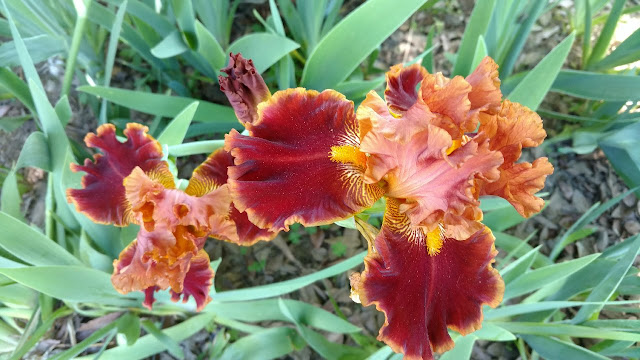
Now is the time to plant this beautiful water-wise perennial

|
|
To get beautiful iris blooms like this, plant rhizomes in midsummer. Find a huge selection of rhizomes at the Sacramento Iris Society sale this weekend. (Photo: Debbie Arrington)
|
Bearded irises rank among the best drought-tolerant perennials for Sacramento gardens. And here’s your chance to get a bunch to plant now.
On Saturday and Sunday, July 16 and 17, the Sacramento Iris Society will host its annual rhizome sale at Shepard Garden and Arts Center. Think of it as a bare-root sale for irises; rhizomes are irises’ fleshy underground stems.
Mid to late summer is the best time to plant (or divide and transplant) bearded irises, which is why this plant sale is a mid-July staple. Bearded irises need very little summer irrigation, once established. Planted now, they’ll bloom next March and April.
The iris is named for the Greek goddess of the rainbow because the flowers come in so many hues. Find scores of varieties in every color (and many dazzling combinations) from pure white to (almost) pure black. Reblooming irises – which produce flowers in both spring and fall – will also be available.
Sale hours are 9 a.m. to 3 p.m. each day. Parking and admission are free. Come early for the best selection. Club members will be on hand to offer advice, not just in choosing varieties but how to care for those rhizomes once you get them home and how to keep them thriving for years ahead.
Shepard Center is located at 3330 McKinley Blvd., Sacramento.
Details: https://sacramentoirissocietydotcom.wordpress.com/
Comments
0 comments have been posted.Sacramento Digs Gardening to your inbox.
Food in My Back Yard Series
May 6: Maintain soil moisture with mulch for garden success
April 29: What's (already) wrong with my tomato plants?
April 22: Should you stock up on fertilizer? (Yes!)
April 15: Grow culinary herbs in containers
April 8: When to plant summer vegetables
April 1: Don't be fooled by these garden myths
March 25: Fertilizer tips: How to 'feed' your vegetables for healthy growth
March 18: Time to give vegetable seedlings some more space
March 11: Ways to win the fight against weeds
March 4: Potatoes from the garden
Feb. 25: Plant a fruit tree now -- for later
Feb. 18: How to squeeze more food into less space
Feb. 11: When to plant? Consider staggering your transplants
Feb. 4: Starting in seed starting
Sites We Like
Garden Checklist for week of May 11
Make the most of the lower temperatures early in the week. We’ll be back in the 80s by Thursday.
* Plant, plant, plant! It’s prime planting season in the Sacramento area. Time to set out those tomato transplants along with peppers and eggplants. Pinch off any flowers on new transplants to make them concentrate on establishing roots instead of setting premature fruit.
* Direct-seed melons, cucumbers, summer squash, corn, radishes, pumpkins and annual herbs such as basil.
* Harvest cabbage, lettuce, peas and green onions.
* In the flower garden, direct-seed sunflowers, cosmos, salvia, zinnias, marigolds, celosia and asters. (You also can transplant seedlings for many of the same flowers.)
* Plant dahlia tubers.
* Transplant petunias, marigolds and perennial flowers such as astilbe, columbine, coneflowers, coreopsis, dahlias, rudbeckia and verbena.
* Keep an eye out for slugs, snails, earwigs and aphids that want to dine on tender new growth.
* Feed summer bloomers with a balanced fertilizer.
* For continued bloom, cut off spent flowers on roses as well as other flowering plants.
* Add mulch to the garden to maintain moisture. Mulch also cuts down on weeds. But don’t let it mound around the stems or trunks of trees or shrubs. Leave about a 6-inch-to-1-foot circle to avoid crown rot or other problems.
* Remember to weed! Pull those nasties before they set seed.
* Water early in the day and keep seedlings evenly moist.